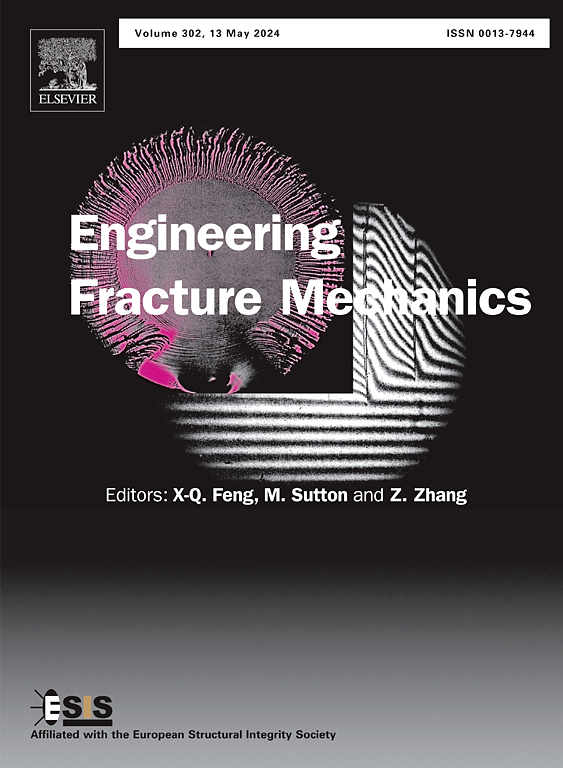Numerical simulation study on hydraulic fracture propagation of multi-cluster fracturing of horizontal well in deep fractured coal seams
IF 4.7
2区 工程技术
Q1 MECHANICS
引用次数: 0
Abstract
In recent years, deep coalbed methane has emerged as a focal point for exploration and development, achieving significant success in extraction through large-scale fracturing measures. However, the widespread development of cleat/fracture systems within coal seams has a significant impact on the propagation of hydraulic fractures, and the increasing stress differences caused by deeper burial depths make hydraulic fracturing more challenging. As a result, this study establishes a hydraulic fracturing model for fractured coal seam using a three-dimensional lattice method, and investigates the impact of cleat/ natural fractures, deep geological stress environments, and engineering intervention measures on the propagation of hydraulic fractures. The results indicate that the existence of cleat/ natural fractures in coal seams induces the formation of a complex fracture network system for hydraulic fractures, however the difference in stimulation volume among various perforation clusters increases. When natural fractures near the wellbore are aligned with the direction of hydraulic fractures propagation, the initiation pressure can be significantly lowered. Under different stress regimes, the reverse stress regime exhibits poor stimulation effects, tending to form horizontal fractures, manifesting as “T” and “Z” shaped fractures; the normal stress regime and strike-slip stress regime can form a considerable scale of primary fractures and branch fractures, which is more favorable for the formation of fracture networks. However, an increase in horizontal stress difference promotes hydraulic fractures length growth. When the horizontal stress difference is 12 MPa, hydraulic fractures can develop uniformly and the dynamic distribution of fracturing fluid tends to stabilize. Increasing the fracturing fluid viscosity reduces the reconstruction volume and shortens the fracture length, which is detrimental to the development of long fractures. However, the rapid increase of pumping volume of fracture fluid is most beneficial to the development of fracture length and improves the efficiency of fracturing fluid, making it the most effective for the transformation of fractured coal seams. The results provide a better understanding of the hydraulic fractures propagation mechanism in deep fractured coal seams, offering a reference for the engineering transformation of deep fractured coal seams.
近年来,深层煤层气已成为勘探和开发的重点,通过大规模压裂措施,在开采方面取得了巨大成功。然而,煤层中广泛发育的裂隙/断裂系统对水力压裂的传播产生了重大影响,埋藏深度加深导致的应力差异增大使水力压裂更具挑战性。因此,本研究采用三维网格法建立了裂隙煤层水力压裂模型,并研究了裂隙/天然裂缝、深部地质应力环境和工程干预措施对水力压裂传播的影响。结果表明,煤层中裂隙/天然裂缝的存在会促使水力压裂形成复杂的裂缝网络系统,但不同射孔群之间的刺激量差异会增大。当井筒附近的天然裂缝与水力压裂传播方向一致时,可显著降低启动压力。在不同的应力体系下,反向应力体系的激励效果较差,倾向于形成水平裂缝,表现为 "T "形和 "Z "形裂缝;正向应力体系和走向滑动应力体系可以形成相当规模的原生裂缝和分支裂缝,更有利于裂缝网络的形成。然而,水平应力差的增加会促进水力断裂长度的增长。当水平应力差为12兆帕时,水力裂缝可以均匀发育,压裂液的动态分布趋于稳定。提高压裂液粘度会减少重建量,缩短裂缝长度,不利于长裂缝的发育。然而,快速增加压裂液的泵送量最有利于裂缝长度的发育,提高了压裂液的效率,对裂缝煤层的改造最为有效。研究结果加深了对深部断裂煤层水力裂缝扩展机理的认识,为深部断裂煤层的工程改造提供了参考。
本文章由计算机程序翻译,如有差异,请以英文原文为准。
求助全文
约1分钟内获得全文
求助全文
来源期刊
CiteScore
8.70
自引率
13.00%
发文量
606
审稿时长
74 days
期刊介绍:
EFM covers a broad range of topics in fracture mechanics to be of interest and use to both researchers and practitioners. Contributions are welcome which address the fracture behavior of conventional engineering material systems as well as newly emerging material systems. Contributions on developments in the areas of mechanics and materials science strongly related to fracture mechanics are also welcome. Papers on fatigue are welcome if they treat the fatigue process using the methods of fracture mechanics.

 求助内容:
求助内容: 应助结果提醒方式:
应助结果提醒方式:


